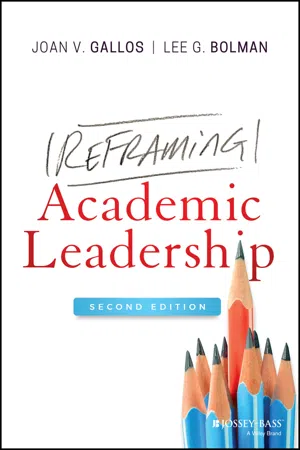
- English
- ePUB (mobile friendly)
- Available on iOS & Android
Reframing Academic Leadership
About this book
Reframing Academic Leadership is the go-to guide for deepening leadership commitment, capacity, and impact. Gallos and Bolman tease out the unique opportunities and challenges in academic leadership and present powerful ideas and tools to guide and assist college and university administrators in:
In this updated edition, the authors integrate time-tested conceptual frameworks with rich and compelling real-world cases and tackle contemporary, high-impact issues such as changes in the professoriate and in student populations, funding shortfalls, equity and social justice, the double-edged sword of technology, managing conflict and crisis, ethics and governance, and strengthening leadership agility and resolve. This readable, intellectually provocative, and pragmatic book is for all who care deeply about higher education, are committed to making it better, and understand its potential to transform lives, families, communities, organizations, and nations. Leadership matters more than ever, and Reframing Academic Leadership offers the seminal framework for understanding and leading in higher education today.
PRAISE FOR REFRAMING ACADEMIC LEADERSHIP | 1st ED
"Reframing Academic Leadership is the most comprehensive book on the topic and an excellent source of knowledge for faculty and managerial leaders in every college and university. An invaluable resource for students of higher education leadership!"
—MAUREEN SULLIVAN, Past President, American Library Association and Association of College and Research Libraries
"Reframing Academic Leadership provides a compassionate understanding of the stresses of leadership in higher education. It offers insights to those who do not fully appreciate why higher education is so hard to 'manage' and validation for those entirely familiar with this world. I recommend it enthusiastically."
—JUDITH BLOCK MCLAUGHLIN, Senior lecturer on education and faculty chair of the Harvard Seminar for New Presidents and the Harvard Seminar for Presidential Leadership, Harvard Graduate School of Education
"Bolman and Gallos provide a refreshing view of leadership essential for those assuming presidencies and other important leadership positions in higher education. This work is a bedside reference for aspiring and current leadership in higher education not only in the U.S. but also abroad."
—FERNANCO LEON GARCIA, President, Sistema CETYS Universidad, Baja California, Mexico
"Bolman and Gallos have written a practical, lucid text that brings together illustrative vignettes and robust frameworks for diagnosing and managing colleges and universities. I recommend it to new and experienced administrators who will routinely confront difficult people, structures, and cultures in their workplaces."
—CHRISTOPHER MORPHEW, Dean, School of Education, Johns Hopkins University
"Reframing Academic Leadership is filled with real-world examples from leaders. The book reads like a guide for leading a chamber music rehearsal where one's role constantly shifts from star to servant and where multiple answers may be 'right'."
—PETER WHITE, Dean and Professor of Conducting, Conservatory of Music, University of the Pacific
Frequently asked questions
- Essential is ideal for learners and professionals who enjoy exploring a wide range of subjects. Access the Essential Library with 800,000+ trusted titles and best-sellers across business, personal growth, and the humanities. Includes unlimited reading time and Standard Read Aloud voice.
- Complete: Perfect for advanced learners and researchers needing full, unrestricted access. Unlock 1.4M+ books across hundreds of subjects, including academic and specialized titles. The Complete Plan also includes advanced features like Premium Read Aloud and Research Assistant.
Please note we cannot support devices running on iOS 13 and Android 7 or earlier. Learn more about using the app.
Information
Part I
Leadership Epistemology: When You Understand, You Know What to Do
1
A Tale of Two Presidents: Opportunities and Challenges in Academic Leadership
Table of contents
- Cover
- Table of Contents
- Title Page
- Copyright
- Preface
- About the Authors
- Part I: Leadership Epistemology: When You Understand, You Know What to Do
- Part II: Reframing Leadership Challenges
- Part III: Leadership Pragmatics: New Ideas for Old Challenges
- Part IV: Leadership in a Changing World
- Part V: Sustaining Higher Education Leaders: Courage, Hope, and Values
- References
- Index
- End User License Agreement